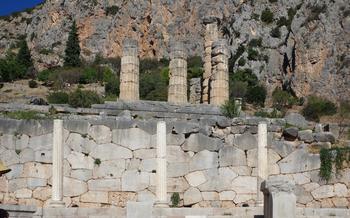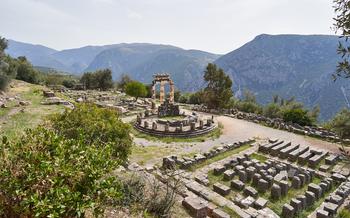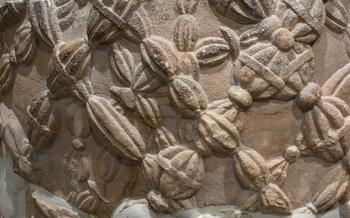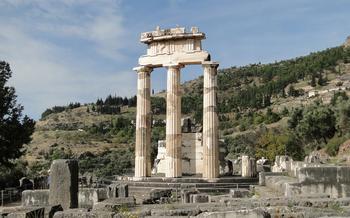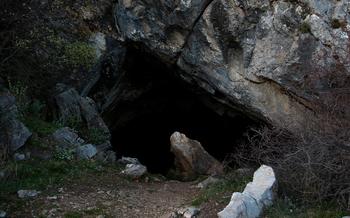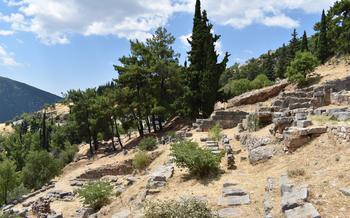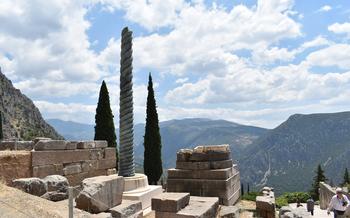
The Votive Offerings of the Oracle Museum
- Delphi: An Ancient Sanctuary and Oracle
- The Votive Offerings Museum: A Treasure Trove of Ancient Artifacts
- Exploring the Museum's Collection
- The Charioteer of Delphi: A Bronze Masterpiece
- The Sphinx of Naxos: A Majestic Guardian
- The Treasury of Athens: A Monument to Athenian Power
- The Tholos of Delphi: A Circular Masterpiece
- The Oracle's Precinct: Seeking Divine Guidance
- The Castalian Spring: A Sacred Water Source
- The Archaeological Museum of Delphi: A Wealth of Discoveries
- The European Cultural Centre of Delphi: A Modern Legacy
- The Delphi Festival: A Celebration of Arts and Culture
- Hiking Trails: Exploring the Natural Beauty
- Insider Tip: Planning Your Visit
Delphi: An Ancient Sanctuary and Oracle
In the heart of ancient Greece, nestled amidst the majestic peaks of Mount Parnassus, lies the sacred site of Delphi—a place where myth, history, and nature intertwine. For centuries, Delphi served as a religious center of immense significance, home to the renowned Oracle of Delphi, whose prophecies influenced the course of Greek history.
The sacred landscape of Delphi is a testament to its profound spiritual significance. The sanctuary's layout, with its temples, treasuries, and theaters, reflects the harmonious integration of architecture with the surrounding environment. The awe-inspiring natural beauty of Delphi, with its towering cliffs and lush forests, further enhances the sense of reverence and tranquility that permeates the site.
During my visit to Delphi, I experienced an overwhelming sense of connection to the ancient world. As I wandered through the ruins, I could almost hear the echoes of pilgrims seeking guidance from the Oracle, the cheers of athletes competing in the Pythian Games, and the whispers of history unfolding. Delphi is a place where the past is not just remembered but truly felt, a place where the sacred energy of ancient Greece still lingers in the air.
The Votive Offerings Museum: A Treasure Trove of Ancient Artifacts
Within the walls of the Votive Offerings Museum, a treasure trove of ancient artifacts awaits, each piece whispering tales of devotion, gratitude, and the deep faith that permeated ancient Greek society. These offerings, dedicated to the gods by grateful visitors who sought their favor or expressed their thanks for blessings received, provide a tangible glimpse into the religious practices and beliefs of the ancient Greeks.
The museum's collection is a testament to the diversity and richness of ancient Greek culture. Statues of gods and goddesses, intricately carved from marble or cast in bronze, stand tall, their serene expressions belying the turbulent history they have witnessed. Jewelry, fashioned from precious metals and adorned with gemstones, sparkles with the same brilliance it did centuries ago when it adorned the bodies of wealthy patrons.
Weapons, shields, and helmets, once wielded by brave warriors in defense of their homeland, hang on the walls, a silent tribute to their valor and sacrifice. Pottery, with its delicate forms and intricate designs, offers a glimpse into the everyday lives of the ancient Greeks, their domestic rituals and celebrations.
Each offering, whether grand or humble, bears witness to the profound connection between the ancient Greeks and their gods. They are not merely objects of art or historical relics; they are windows into the soul of a civilization that revered the divine and sought its guidance in every aspect of life.
Exploring the Museum's Collection
The Votive Offerings Museum in Delphi is a treasure trove of ancient artifacts, meticulously organized to provide visitors with an immersive journey through the history and culture of ancient Greece. The exhibits are arranged chronologically, allowing visitors to trace the evolution of artistic styles and techniques over time. Highlights of the collection include the iconic bronze Charioteer of Delphi, the majestic Sphinx of Naxos, and the exquisite gold and ivory statues of the gods.
Interactive exhibits and educational resources enhance the visitor experience, providing insights into the significance and symbolism of the offerings. Informative panels and audio guides offer detailed explanations, while touchscreens and interactive displays allow visitors to explore the artifacts in greater depth. Museum guides are also available to provide personalized tours and share their knowledge and expertise.
A visit to the museum is a truly immersive experience, transporting visitors back in time to the vibrant world of ancient Greece. The carefully curated collection offers a glimpse into the beliefs, rituals, and artistic achievements of the ancient Greeks, providing a deeper understanding of their rich cultural heritage.
The Charioteer of Delphi: A Bronze Masterpiece
Amidst the treasures of Delphi, one artifact stands out as a testament to ancient Greek artistry and craftsmanship: the Charioteer of Delphi. This iconic bronze statue, dating back to the 5th century BC, is a masterpiece of classical sculpture that has captivated visitors for centuries.
Measuring over two meters in height, the Charioteer exudes an air of power and grace. The charioteer's intricate details, from the finely rendered facial features to the flowing folds of his garments, showcase the exceptional skill of the ancient Greek sculptors. The bronze casting technique, with its smooth surfaces and sharp edges, further enhances the statue's lifelike appearance.
The historical context of the Charioteer of Delphi adds to its significance. It was likely commissioned to commemorate a victory in a chariot race, a popular sporting event in ancient Greece. The statue's placement within the sanctuary suggests that the victor dedicated it to Apollo, the patron god of Delphi, in gratitude for his triumph.
Standing before the Charioteer of Delphi is a humbling experience. Its awe-inspiring presence transports visitors back in time, allowing them to glimpse the grandeur and artistry of ancient Greece. The statue's timeless beauty and historical significance make it a must-see for anyone exploring the wonders of Delphi.
Anecdote:
As I gazed upon the Charioteer of Delphi, its intricate details and lifelike features left me in awe. I couldn't help but imagine the moment when the victor of that ancient chariot race first laid eyes on his magnificent bronze likeness, a symbol of his triumph and devotion to Apollo. The statue seemed to emanate a sense of pride and accomplishment, as if sharing the victor's joy with all who beheld it.
The Sphinx of Naxos: A Majestic Guardian
In the heart of the ancient sanctuary, the Sphinx of Naxos stands tall, its majestic presence captivating all who behold it. This colossal marble statue, dating back to the 6th century BC, is an iconic landmark of Delphi, embodying the essence of protection and guardianship.
Carved from a single block of Naxian marble, the Sphinx exudes power and authority. Its enigmatic gaze, framed by a regal headdress, seems to pierce through time, inviting visitors to unravel its secrets. The intricate details of its wings, adorned with intricate feathers, lend an air of grace and elegance to this imposing creature.
While the exact origins of the Sphinx remain shrouded in mystery, its symbolic significance is undeniable. As a mythical creature with the body of a lion and the head of a human, the Sphinx represents the strength, wisdom, and enigma that were so revered in ancient Greek culture. It served as a guardian of the sanctuary, warding off evil spirits and protecting the sacred precinct from harm.
The Sphinx of Naxos stands as a testament to the artistic prowess of ancient Greek sculptors. Its harmonious proportions and lifelike features showcase their mastery of anatomy and their ability to capture the essence of mythical creatures. The statue's weathered surface, bearing the marks of time, adds to its mystique and allure, evoking a sense of awe and wonder.
As the sun sets over Delphi, casting a golden glow on the ancient ruins, the Sphinx of Naxos takes on a magical aura. Its shadow stretches across the sacred landscape, creating an ethereal atmosphere that transports visitors back in time. In the fading light, the Sphinx seems to come alive, its enigmatic gaze guiding them through the mysteries of the ancient oracle.
The Treasury of Athens: A Monument to Athenian Power
Amidst the sacred monuments of Delphi, the Treasury of Athens stands as a testament to the wealth and influence of the ancient city-state. Constructed in the 5th century BC, this well-preserved treasury building showcases the architectural prowess and artistic refinement of the Athenians. Its Doric columns, intricate friezes, and pedimental sculptures narrate tales of mythological heroes and Athenian triumphs. Step inside to admire the treasury's spacious interior, which once housed precious offerings dedicated to the gods by the grateful people of Athens. The Treasury of Athens serves as a tangible reminder of the city's political and cultural dominance during the Golden Age of Greece, standing proudly as a symbol of Athenian power and prestige.
Anecdote:
As I explored the Treasury of Athens, I couldn't help but imagine the bustling activity that would have filled its halls in ancient times. I envisioned Athenian officials presenting their offerings to the gods, seeking divine favor and protection for their city. The treasury's intricate carvings seemed to come alive, telling stories of battles won, alliances forged, and the enduring legacy of Athens. Standing within its walls, I felt a deep connection to the past, humbled by the accomplishments of a civilization that continues to inspire awe and admiration to this day.
The Tholos of Delphi: A Circular Masterpiece
Among the architectural wonders of Delphi, the Tholos stands out as a unique and captivating structure. This circular building, dating back to the 4th century BC, served as a ceremonial space within the sacred sanctuary. Its distinctive design and construction techniques showcase the advanced engineering skills of the ancient Greeks.
The Tholos features a circular colonnade of 20 Doric columns, supporting a conical roof. The columns' elegant proportions and the intricate carvings on their capitals add to the building's visual appeal. The interior of the Tholos is equally impressive, with its circular cella surrounded by a bench-like structure.
The exact function of the Tholos remains a subject of debate among scholars. Some believe it was used for religious rituals, such as the worship of Apollo, while others suggest it served as a meeting place for the Amphictyonic League, a council of representatives from various Greek city-states.
Visiting the Tholos is a truly awe-inspiring experience. As you step inside, the circular space creates a sense of intimacy and contemplation. The play of light and shadow through the columns adds to the building's ethereal atmosphere. Imagine yourself transported back in time, witnessing ancient ceremonies or important political discussions taking place within these sacred walls.
Anecdote:
During my visit to Delphi, I had the privilege of witnessing a reenactment of an ancient ceremony within the Tholos. The reenactment was part of a cultural festival that aimed to bring the ancient world to life. As actors dressed in traditional Greek attire performed rituals and recited prayers, I felt a profound connection to the past. The Tholos, with its timeless presence, provided the perfect backdrop for this immersive experience.
The Oracle's Precinct: Seeking Divine Guidance
Within the sacred confines of Delphi, the Oracle's Precinct stood as a place of profound reverence and awe. Here, the Oracle, known as the Pythia, delivered her cryptic prophecies, influencing the course of history and shaping the destinies of individuals and nations alike. The process of divination was shrouded in mystery and ritual. The Pythia, chosen for her purity and piety, would enter a trance-like state, inhaling sacred vapors emanating from a hidden chasm. In her altered state, she would utter enigmatic pronouncements, which were then interpreted by priests and recorded for posterity.
Seeking guidance from the Oracle was a solemn and momentous undertaking. Individuals, city-states, and even foreign rulers would dispatch emissaries to Delphi, bearing questions of war, peace, colonization, and personal destiny. The Oracle's prophecies, often ambiguous and open to interpretation, carried immense weight and were believed to hold the power to sway the course of events. From the mundane to the momentous, the Oracle's words shaped the lives of countless individuals and influenced the trajectory of the ancient world.
As visitors step into the Oracle's Precinct, they can almost feel the weight of history pressing down upon them. The sacred atmosphere, palpable even centuries later, invites contemplation and reflection. It is here that the divine and the mortal intersected, where the fates of men and nations were intertwined, and where the echoes of ancient prophecies still linger in the air.
The Castalian Spring: A Sacred Water Source
In the heart of Delphi, nestled amidst the sacred landscape, lies the Castalian Spring, a natural water source revered by the ancient Greeks. Considered sacred, the spring was believed to possess purifying and inspiring properties, making it an integral part of religious ceremonies and rituals. According to mythology, the spring was discovered by the demigod Pegasus, who struck the ground with his hoof, causing the water to gush forth.
The Castalian Spring was a place of pilgrimage for those seeking guidance and inspiration from the Oracle of Delphi. Before consulting the Oracle, it was customary for visitors to undergo a purification ritual by bathing in the spring's refreshing waters. The spring was also associated with the Muses, the goddesses of the arts, who were believed to reside near its banks, inspiring poets, musicians, and artists.
Even today, the Castalian Spring continues to attract visitors from around the world who come to experience its sacred aura and refreshing waters. Located just a short walk from the archaeological site, the spring offers a tranquil retreat, inviting visitors to pause and reflect amidst the ancient ruins. As you sip the cool, clear water from the spring, you can't help but feel a sense of connection to the past, as if you're partaking in a ritual that has been performed for centuries.
The Archaeological Museum of Delphi: A Wealth of Discoveries
The Archaeological Museum of Delphi, located near the ancient sanctuary, houses a vast collection of artifacts unearthed during excavations at the site. The museum's chronologically organized displays take visitors on a journey through Delphi's history, from its humble beginnings to its rise as a prominent religious and cultural center.
Among the museum's treasures are exquisite sculptures, intricate pottery, finely crafted jewelry, and fascinating inscriptions. These artifacts provide valuable insights into the lives, beliefs, and artistic achievements of the ancient Greeks. Visitors can admire stunning bronze statues, delicate marble carvings, and finely painted vases, each with its own unique story to tell.
One particularly captivating artifact is a bronze statue of a young athlete, known as the "Delphi Charioteer." This life-size sculpture, dating back to the 5th century BC, depicts a victorious charioteer standing beside his chariot. The intricate details of the statue, from the athlete's muscular physique to the finely rendered folds of his clothing, showcase the exceptional skill of ancient Greek artisans.
The Archaeological Museum of Delphi offers a comprehensive overview of the sanctuary's rich history and cultural significance. Whether you're an archaeology enthusiast, a history buff, or simply someone with an appreciation for ancient art, this museum is a must-visit destination.
The European Cultural Centre of Delphi: A Modern Legacy
Amidst the ancient ruins and historical significance of Delphi, the European Cultural Centre stands as a beacon of contemporary arts and dialogue. Established in 1989, the center is dedicated to fostering cultural exchange and promoting artistic expression within the region.
Throughout the year, the center organizes a diverse range of events, exhibitions, and workshops that bring together artists, intellectuals, and enthusiasts from around the world. These events not only showcase the richness of Greek culture but also encourage cross-cultural collaboration and the exploration of new artistic frontiers.
The center's commitment to preserving and promoting Delphi's cultural heritage is evident in its various initiatives. It hosts lectures, seminars, and conferences that delve into the history, archaeology, and mythology of the ancient sanctuary. It also works closely with local communities to ensure that Delphi's unique cultural traditions are passed down to future generations.
One of the highlights of the center's activities is the annual Delphi Festival. This prestigious event brings together renowned artists, musicians, and performers from around the world to celebrate Greek culture and heritage through contemporary artistic expression. The festival features a variety of performances, exhibitions, and educational programs that attract visitors from across Greece and beyond.
A personal anecdote:
During my visit to Delphi, I had the opportunity to attend a performance at the European Cultural Centre. The event showcased the works of contemporary Greek artists who used their art to explore themes of identity, tradition, and modernity. The vibrant atmosphere and the thought-provoking performances left a lasting impression on me, reminding me of the power of art to bridge the gap between past and present.
The Delphi Festival: A Celebration of Arts and Culture
Amidst the ancient ruins and sacred landscapes of Delphi, the Delphi Festival stands as a vibrant tribute to the region's rich cultural heritage. Every summer, this renowned festival transforms the town into a stage, bringing together renowned artists, performers, and enthusiasts from around the world.
The festival's diverse program encompasses a kaleidoscope of artistic expressions, from classical music concerts and theatrical performances to contemporary dance and visual arts exhibitions. The ancient theater of Delphi, with its awe-inspiring acoustics and panoramic views, serves as a majestic backdrop for these captivating events.
Beyond the main stage, the festival spills into the streets and public spaces of Delphi, creating an immersive atmosphere where art and culture intertwine. Workshops, lectures, and interactive installations invite visitors to engage with artists and explore the creative process.
The Delphi Festival is not merely a celebration of the past but also a platform for contemporary artistic expression. It provides a space for emerging artists to showcase their talents and for established figures to experiment with new ideas.
The festival's international recognition attracts visitors from across the globe, creating a unique opportunity for cultural exchange and dialogue. Whether you're an art enthusiast, a history buff, or simply seeking an unforgettable experience, the Delphi Festival promises an inspiring journey through the realms of creativity and heritage.
Anecdote:
In the twilight hours of a summer evening, I found myself immersed in the magic of the Delphi Festival. As the sun cast a golden glow on the ancient ruins, the melodies of a traditional Greek orchestra filled the air, transporting me to another era.
In the heart of the ancient theater, surrounded by an audience captivated by the performance, I felt a profound connection to the spirit of Delphi. The festival's alchemy of art, history, and nature created an unforgettable moment, reminding me of the enduring power of creativity to bridge time and cultures.
Hiking Trails: Exploring the Natural Beauty
Beyond the ancient ruins and sacred sites, Delphi offers a breathtaking natural landscape that can be explored through a network of scenic hiking trails. These trails wind through lush forests, past sparkling streams, and up to panoramic viewpoints, showcasing the stunning beauty of the region.
Whether you're an experienced hiker or prefer a leisurely stroll, there's a trail to suit your fitness level and interests. Some trails meander through the olive groves and vineyards surrounding Delphi, offering a chance to admire the tranquil countryside and learn about local agriculture. Others lead to ancient sites hidden among the hills, where you can explore the ruins of forgotten temples and fortifications.
One of the most popular trails is the path to the Corycian Cave, a vast underground chamber with a rich history and mythology. According to legend, the cave was the birthplace of the Greek god Pan, and it was also a sacred site for the worship of Dionysus. The trail to the cave is moderately challenging, but the stunning views and the opportunity to explore this ancient site make it well worth the effort.
Hiking in Delphi is a fantastic way to combine your love of history and nature. As you traverse the trails, you'll encounter ancient ruins, stunning viewpoints, and a diverse array of flora and fauna. Remember to bring comfortable shoes, water, and a camera to capture the breathtaking scenery.
Insider Tip: Planning Your Visit
To make the most of your visit to Delphi, timing is key. Aim for spring or autumn to avoid the summer crowds and scorching temperatures. The shoulder seasons offer pleasant weather and fewer tourists, allowing you to explore the site at a more relaxed pace.
Navigating Delphi's extensive ruins can be overwhelming, so plan your route in advance. Start with the main highlights, such as the Treasury of Athens, the Tholos, and the Oracle's Precinct. Consider hiring a guide for in-depth insights and historical context.
For an authentic culinary experience, venture beyond the tourist traps and seek out local tavernas. Indulge in traditional Greek dishes such as moussaka, pastitsio, and fresh seafood. The town of Arachova, a short drive from Delphi, offers a charming atmosphere and a variety of dining options.
Accommodation in Delphi ranges from budget hostels to luxurious hotels. For a unique stay, consider the historic Hotel Apollon, housed in a 19th-century mansion with stunning views of the valley.
Insider Tip: Embark on a memorable hike to the Corycian Cave, located about 12 kilometers from Delphi. The cave's impressive stalactites and stalagmites create a mystical ambiance. Enjoy a leisurely walk through the surrounding olive groves and soak in the breathtaking views of the Delphi valley.

